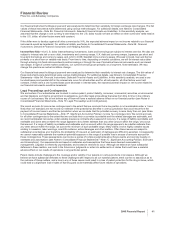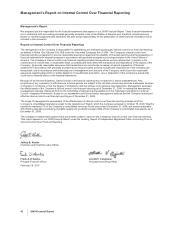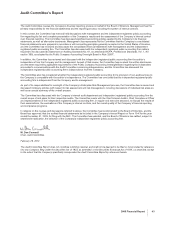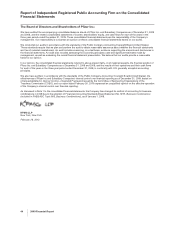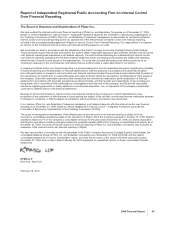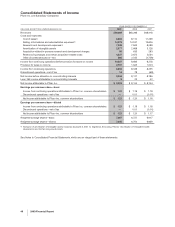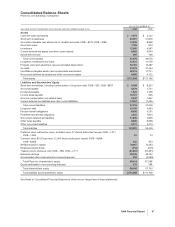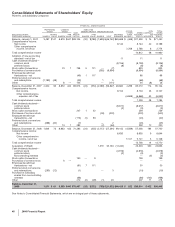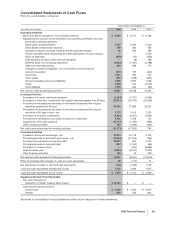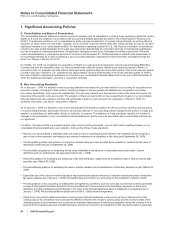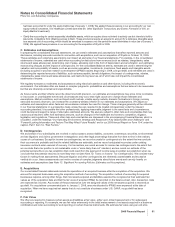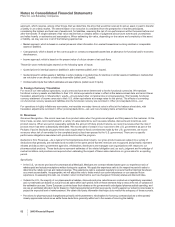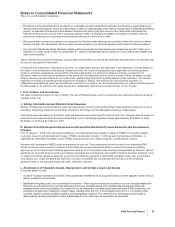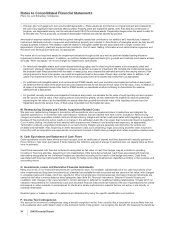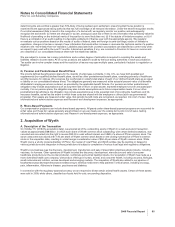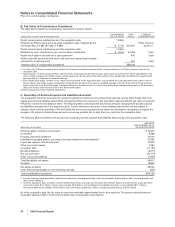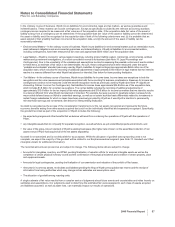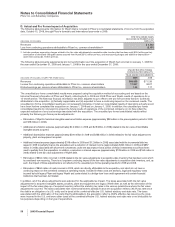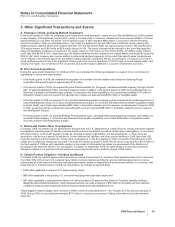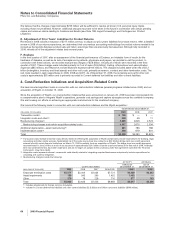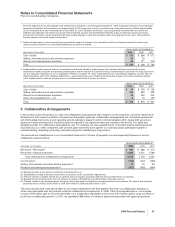Pfizer 2009 Annual Report Download - page 53
Download and view the complete annual report
Please find page 53 of the 2009 Pfizer annual report below. You can navigate through the pages in the report by either clicking on the pages listed below, or by using the keyword search tool below to find specific information within the annual report.
Notes to Consolidated Financial Statements
Pfizer Inc. and Subsidiary Companies
had been accounted for under the equity method (as of January 1, 2009). We applied these provisions in our accounting for our new
equity method investment, ViiV Healthcare Limited (see Note 3A. Other Significant Transactions and Events: Formation of ViiV, an
Equity-Method Investment).
•Clarify the accounting for certain separately identifiable assets, which an acquirer does not intend to actively use but intends to hold to
prevent its competitors from obtaining access to them. These provisions require an acquirer to account for a defensive intangible asset
as a separate unit of accounting, which should be amortized to expense over the period the asset diminishes in value (as of January 1,
2009). We applied these provisions in our accounting for the acquisition of Wyeth in 2009.
C. Estimates and Assumptions
In preparing the consolidated financial statements, we use certain estimates and assumptions that affect reported amounts and
disclosures, including amounts recorded in connection with acquisitions, such as our acquisition of Wyeth on October 15, 2009.
These estimates and underlying assumptions can impact all elements of our financial statements. For example, in the consolidated
statements of income, estimates are used when accounting for deductions from revenues (such as rebates, chargebacks, sales
returns and sales allowances), determining cost of sales, allocating cost in the form of depreciation and amortization, and estimating
restructuring charges and the impact of contingencies. On the consolidated balance sheets, estimates are used in determining the
valuation and recoverability of assets, such as accounts receivables, investments, inventories, fixed assets and intangible assets
(including acquired in-process research & development (IPR&D) assets, beginning in 2009, and goodwill), and estimates are used in
determining the reported amounts of liabilities, such as taxes payable, benefit obligations, the impact of contingencies, rebates,
chargebacks, sales returns and sales allowances, and restructuring reserves, all of which also will impact the consolidated
statements of income.
We regularly evaluate our estimates and assumptions using historical experience and other factors, including the economic
environment. Our estimates often are based on complex judgments, probabilities and assumptions that we believe to be reasonable
but that are inherently uncertain and unpredictable.
As future events and their effects cannot be determined with precision, our estimates and assumptions may prove to be incomplete
or inaccurate, or unanticipated events and circumstances may occur that might cause us to change those estimates and
assumptions. Market conditions, such as illiquid credit markets, volatile equity markets, dramatic fluctuations in foreign currency
rates and economic downturn, can increase the uncertainty already inherent in our estimates and assumptions. We adjust our
estimates and assumptions when facts and circumstances indicate the need for change. Those changes generally will be reflected
in our financial statements on a prospective basis unless they are required to be treated retrospectively under the relevant
accounting standard. It is possible that other professionals, applying reasonable judgment to the same facts and circumstances,
could develop and support a range of alternative estimated amounts. We also are subject to other risks and uncertainties that may
cause actual results to differ from estimated amounts, such as changes in the healthcare environment, competition, litigation,
legislation and regulations. These and other risks and uncertainties are discussed in the accompanying Financial Review, which is
unaudited, under the headings “Our Operating Environment, Strategy and Response to Key Opportunities and Challenges” and
“Forward-Looking Information and Factors That May Affect Future Results” and in our 2009 Annual Report on Form 10-K under the
caption, Part 1 Item 1A. “Risk Factors.”
D. Contingencies
We and certain of our subsidiaries are involved in various patent, product liability, consumer, commercial, securities, environmental
and tax litigations and claims; government investigations; and other legal proceedings that arise from time to time in the ordinary
course of our business. Except for income tax contingencies, we record accruals for contingencies to the extent that we conclude
their occurrence is probable and that the related liabilities are estimable, and we record anticipated recoveries under existing
insurance contracts when assured of recovery. For tax matters, we record accruals for income tax contingencies to the extent that
we conclude that a tax position is not sustainable under a “more-likely-than-not” standard, and we record our estimate of the
potential tax benefits in one tax jurisdiction that could result from the payment of income taxes in another tax jurisdiction when we
conclude that the potential recovery is more likely than not (see Note 7D. Taxes on Income: Tax Contingencies). We consider many
factors in making these assessments. Because litigation and other contingencies are inherently unpredictable and excessive
verdicts do occur, these assessments can involve a series of complex judgments about future events and can rely heavily on
estimates and assumptions (see Note 1C. Significant Accounting Policies: Estimates and Assumptions).
E. Acquisitions
Our consolidated financial statements include the operations of an acquired business after the completion of the acquisition. We
account for acquired businesses using the acquisition method of accounting. The acquisition method of accounting for acquired
businesses requires, among other things, that most assets acquired and liabilities assumed be recognized at their estimated fair
values as of the acquisition date and that the fair value of acquired IPR&D be recorded on the balance sheet. Also, transaction costs
are expensed as incurred. Any excess of the purchase price over the assigned values of the net assets acquired is recorded as
goodwill. For acquisitions consummated prior to January 1, 2009, amounts allocated to IPR&D were expensed at the date of
acquisition. When we have acquired net assets that do not constitute a business under U.S. GAAP, no goodwill has been
recognized.
F. Fair Value
We often are required to measure certain assets and liabilities at fair value, either upon initial measurement or for subsequent
accounting or reporting. For example, we use fair value extensively in the initial measurement of net assets acquired in a business
combination and when accounting for and reporting on certain financial instruments. We estimate fair value using an exit price
2009 Financial Report 51


